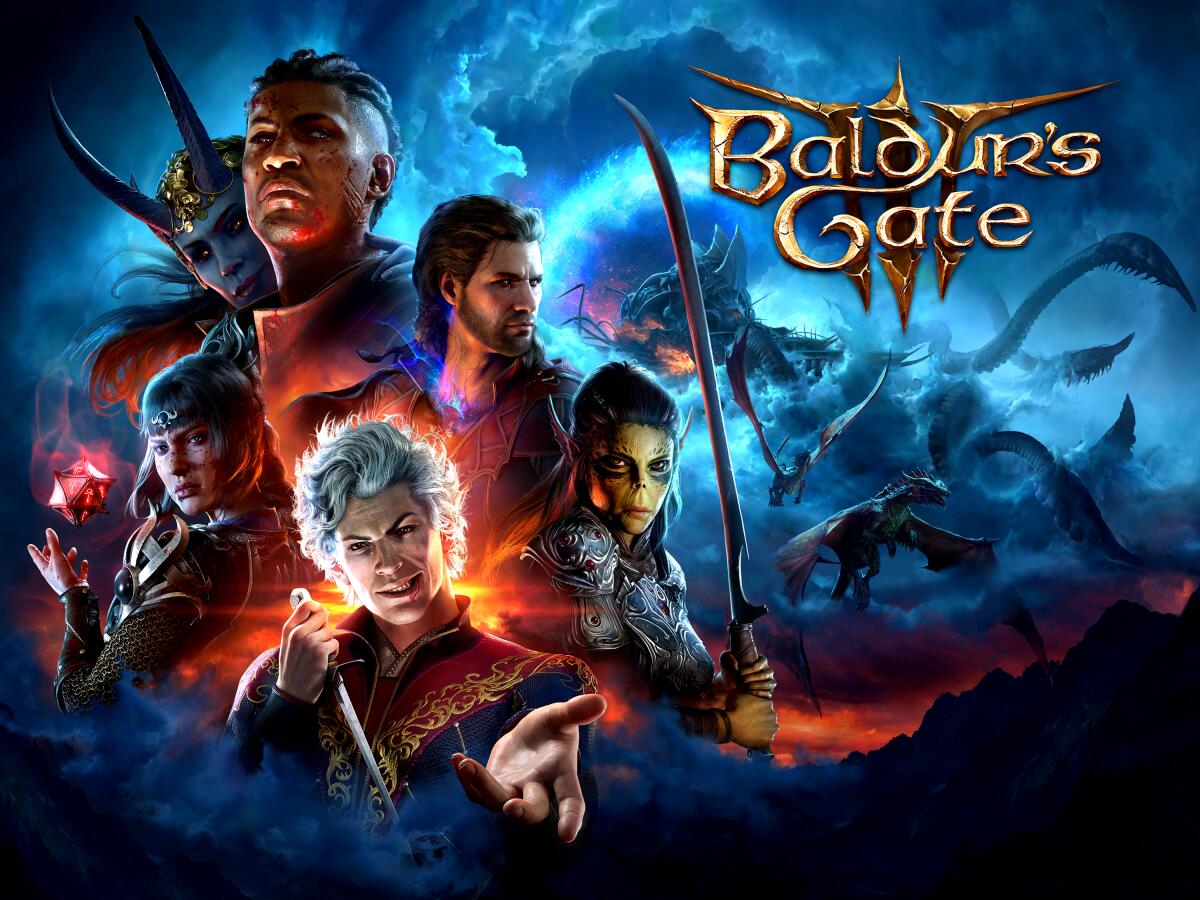The buzziest games this year prove that gamers want old-school couch co-op

An hour into playing the video game “Baldur’s Gate 3” with my husband, we’d already broken the first and probably most ignored rule of “Dungeons & Dragons”: Never split the party.
Separated on opposite ends of a crypt after an unfortunate incident with a trap that set a room ablaze, we had no idea how to get our team — including his gnome monk and my elven cleric — back together without killing us all.
I had a few suggestions (throw a vase on the trap in hopes of disarming it, try to dash through). But after a couple minutes of friendly bickering, we gave up on the trap. I exited my half of the party from the crypt and went all the way around to reunite with my gnomish husband in another room of the building.
Having dodged that disaster, we enjoyed the chance to solve a problem together while uncovering a new realm (even if my partner almost had a meltdown amid the flames).
“Baldur’s Gate 3,” the role-playing game (RPG) set in the universe of “Dungeons & Dragons,” debuted on PC in August with options for single-player and online multiplayer. But the PlayStation 5 version, released last week, introduces a third option: local, or so-called couch co-op, which allows people to play the old-fashioned way on a split screen, sitting side-by-side.
It’s a throwback to the way most people played before online multiplayer — with an in-person human connection, whether at the arcade or at home.
The game’s local co-op allows people to play together in the same room as they navigate quests, romance non-player characters and potentially wreak havoc across the land. Teammates can cooperate in combat and experience the story together, while also taking their characters in different directions — both on the map and morally.
Born out of popular ‘80s and ‘90s games like “Contra,” “GoldenEye 007,” “Secret of Mana” and the original “Diablo,” the modern era of couch co-op games has grown in popularity over the last several years, industry experts said, fueled in part by a pandemic-driven need for quarantine-friendly activities and the desire to bond with friends and family.
Some of the most successful titles of the last several years include or require cooperative play, showing that the co-op gaming experience is more desirable than ever, game experts said.
Action-adventure game “It Takes Two,” in which players take control over a couple on the verge of divorce, won Game of the Year at the Game Awards in 2021. Blizzard published “Diablo 4” in June, with couch co-op as an option in addition to an online multiplayer mode.
Other games, including several “Lego”-themed titles, have also fanned interest in the genre.
“If you’re going to make a multiplayer game in 2023 — if it’s possible — you want that couch co-op because you know people are going to gather around one television set to play,” said Greg Miller, co-founder and chief executive of the entertainment company Kinda Funny, which makes videos and podcasts on video game culture.
In my case, as I was finding my way back into the dank crypt, my husband had somehow started a fight in which he was outnumbered. I was gone for two minutes. But that’s couch co-op. I jumped into the fight, and we won.
That cooperation and conflict from the comfort of your living room is part of the appeal. Couch co-op provides a chance to strategize together, talk about what happened at work and share popcorn while we lob fire bolts and arrows.
“Now you have such a diverse portfolio of local, couch co-op games,” Miller said. “The competitive two teams against each other like ‘Overcooked,’ but then something like ‘Diablo 4.’”
Miller said that while a couch co-op option can make a game more marketable, the impact on sales may be hard to gauge .
Local co-op games can also be more difficult to make because of the demands of rendering a game split-screen — it can also be more expensive.
Still, consumer interest is strong.
“Baldur’s Gate 3” sold around 2.5 million copies during its Early Access period, according to Bloomberg. The PS5 version of “Baldur’s Gate 3” earned a 96 on Metacritic as of Friday, making it among the highest-rated games on the Sony console to date.
“Diablo 4,” meanwhile, broke records for its publisher Blizzard, earning more than $666 million within the first five days of its release. More than 10 million people fought their way through the game in June, according to Activision Blizzard, playing for more than 700 million hours.
For Miller, former editor of the video game and entertainment website IGN, playing a couch co-op game with his wife is more engaging than “just sitting down and watching another Netflix binge session.”
“We went through a quick space there where it seemed like online was going to be the way to go,” he said of co-op gaming. “Then people pretty quickly remembered how much they liked playing games with each other in the same room.”
Larian Studios, the Belgium-based developer behind “Baldur’s Gate 3,” has included couch co-op in its games for years. Two of its popular RPG titles — “Divinity: Original Sin” and its sequel — allow for split-screen play, a feature that Larian’s founder said he insisted on.
“It’s the type of thing that I was missing from every game that I saw on console that I wanted to play together with my wife,” said Swen Vincke, who is also Larian’s chief executive. “We like RPGs and we like really getting into it, but there’s really no ability, or there was very few games that let you go on an adventure together on the same screen.”
Vincke said couch co-op isn’t the biggest-selling feature, but one that provides a unique gaming experience. And despite adding an extra layer of work in game development, he added, it’s worth the effort to create a way for people to play together in person.
Although co-op is more common in “platformer” games that feature running and jumping through a two-dimensional environment, the option is rare in bigger titles because it requires a lot of development, he said.
“I think that there’s actually a missed opportunity in doing so,” he said, noting that people who play games like Larian’s “Divinity: Original Sin 2” together tend to play for a longer period — some more than a year.
Those same people talk about the game with friends, he said, creating a free word-of-mouth marketing campaign. That game sold “similar numbers” for several years, Vincke added.
The heart of couch co-op lies in the joy of accomplishing something together while also engaging in the conflict, emotion and drama of a narrative, Vincke said.
“Every couple, every relationship, there’s a power balance that shifts continuously,” he said. “Playing with that as game developers in the game, and then provoking those emotions in players, it’s cool.”
For some companies, the decision to include couch co-op often comes down to weighing what matters most in a game — gameplay, beautiful graphics and frame rates, or add-ons like micro transactions in-game.
“Some of these games, it’s about driving the most revenue, right?” said Javon Frazier, founder of Maestro Media, a strategic development firm specializing in adapting original IP and pop culture franchises to board and tabletop games. “From a corporate standpoint, that decision is OK, we’re going to give this fully immersive world experience over multiple years and sell as many games as possible. Whereas some of these games are like, ‘No, we’re going give you a great gameplay experience ... that you play with your family.’”
In the end, he said, having the local co-op option often becomes a financial decision.
“We’re paying, you know, $400 million to make the ‘Halo’ game. You want to figure out how you can extrapolate the revenue over a long horizon,” he said. “Whereas ‘Cuphead,’ which I played with my daughter, that was another experience we can both play together and couch co-op, that kind of fit that budget and that level.”
Josef Fares, founder of “It Takes Two’s” Sweden-based developer Hazelight Studios, said part of what makes couch co-op special is that we are “social creatures.” In “It Takes Two,” a young girl’s imagination and desire for her parents to stay together transforms them into toys, forcing them to explore their home and their yard.
“When I pitched the game first, there was lot of, ‘Should we do it two-player only? Why can’t you play it alone? .... This might not sell. This might not reach the right market,’” he said. “I don’t really care about that stuff.”
By all accounts, the game as been a success. In addition to its accolades, Hazelight Studios announced in February that the title sold more than 10 million copies since its March 2021 launch.
Hazelight’s co-op games are more than just a split-screen experience, Fares said — they are designed from the beginning as two-player narratives that promote cooperation and tension, while teasing issues of trust. There can be an edge of competition.
And to play, you really have to communicate with your gaming partner. After all, Fares said, “it’s always more fun to do things together.”
More to Read
Inside the business of entertainment
The Wide Shot brings you news, analysis and insights on everything from streaming wars to production — and what it all means for the future.
You may occasionally receive promotional content from the Los Angeles Times.











